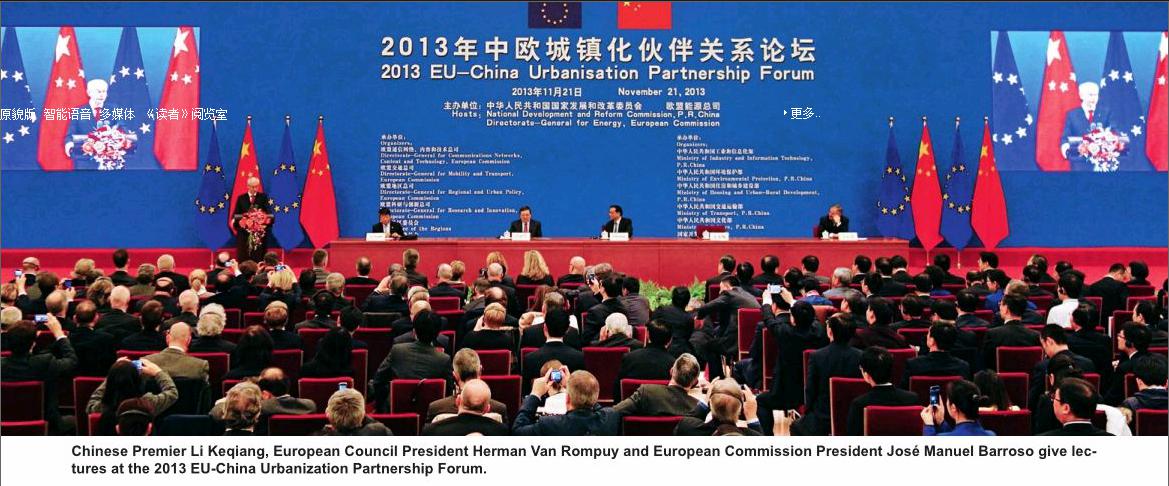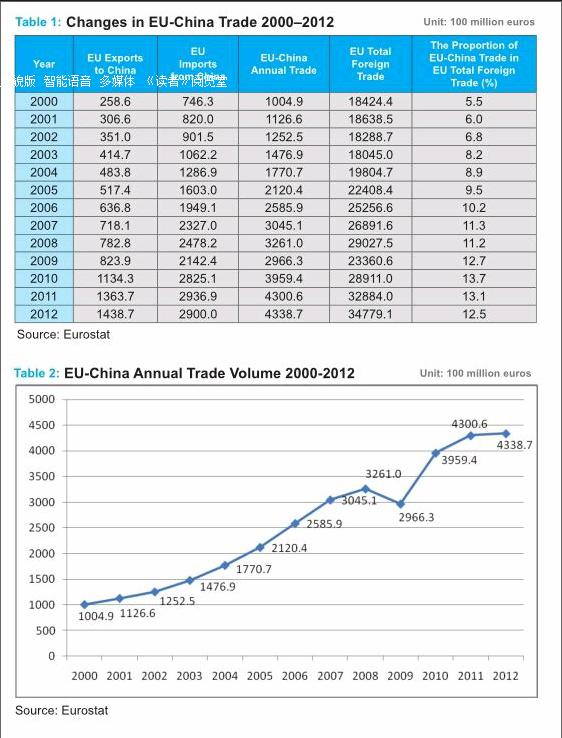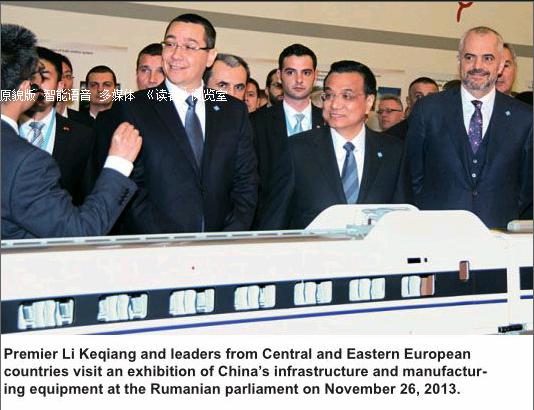China-Europe Relations Undergo Comprehensive Upgrade
By+LI+GANG



CHINA-Europe interaction is gathering pace around the tenth anniversary of the comprehensive strategic partnership between China and the EU. Dutch Prime Minister Mark Rutte visited China in November 2013. A week later, Chinese President Xi Jinping and Premier Li Keqiang met with President of the European Council Herman Van Rompuy and European Commission President Jose Manuel Barroso at the 16th meeting of Chinese and European Union leaders. Shortly after, Li Keqiang attended a meeting of China and Central and Eastern European (CEE) leaders in Romanian capital Bucharest. And early last December, British Prime Minister David Cameron and Chancellor of the Exchequer George Osborne visited China. Relations between China and Europe thus become warmer as cooperation in all aspects grows.
Status Quo and Features of China-EU Relations
The comprehensive partnership between China and the EU was upgraded in 2003 to a comprehensive strategic partnership. A review of this relationship over the past decade shows that it has, on the whole, been strength- ened and expanded, especially in the fields of economy and trade. Certain differences, however, remain with regard to values and such issues as human rights and Tibet.
In 2012, total bilateral trade between the EU and China reached €433.87 billion – 12.5 percent of the EUs total foreign trade, according to Eurostat (Statistical Office of the European Communities) statistics. The EU has been Chinas biggest trade partner for nine consecutive years, and China is the EUs second largest trade partner after the U.S. In 2000, the value of EU exports to China was €25.86 billion. This figure has since surged 4.6-fold to €143.87 billion in 2012. China has thus become the EUs fastest growing export market. Between 2000 and 2012, EU imports from China grew to €300 billion. “Made in China” products are now commonplace in European households.
China is the worlds largest developing country and exporter, while the EU is the worlds largest developed economy. Each has a huge trade volume. But as their economic ties grow, disputes will inevitably occur. The debt crisis in Europe is a main factor in recent trade frictions.
The crisis has left many EU countries mired in unprecedented recession, evident in dwindling consumption, scaled-back investment and high unemployment. The situation has once again raised the specter of protectionism, in the form of further trade remedy investigations into Chinese exports to the EU.

In 2012, the EU initiated 13 anti-dumping investigations, four concerning Chinese exports, and six antisubsidy investigations, three involving Chinese exports, according to European Commission statistics. Tension remained constant in 2013. From June 6 to August 6, the European Commission imposed an 11.8 percent punitive duty on Chinas solar products. As the total volume stands at US $22 billion, this move by the EU was potentially the most costly ever for China. Fortunately the two sides reached a settlement, so avoiding a rise in the duty on Chinese solar panels, cells and wafers to 47.6 percent. A pending trade war was thus defused, but the prospect of future spats remains.
From 2008 to 2011, EU net direct investment in China maintained an upward trend. That in 2008 was €5.95 billion, accounting for 0.06 percent of the EUs total foreign direct investment. By 2011 this figure had almost doubled, having risen to 2.4 percent of EU foreign direct investment.
Chinese corporations investments in the bloc have been gathering strength over past years, having ballooned by a factor of fi ve, year-on-year, in 2009, doubled in 2010 and increased 26.8 percent in 2011. The reverse fl ow has also maintained a healthy momentum. In the first 10 months of 2013, EU investment in China rose 23 percent over the corresponding period of 2012. But there is still room for more growth on both sides. Only two percent of EUs direct outbound investment goes to Chinas mainland, compared with 30 percent to the U.S., according to Karel De Gucht, European Commission Commissioner for Trade. Similarly, only one percent of Chinas foreign direct investment heads for Europe, while 20 percent lands in the U.S.
China and EU have so far established 60 or more dialogue mechanisms, and their cooperation covers 80 fields. Economy and trade constitute the mainstay of their bilateral ties. The economic bond is hence strong, yet frictions erupt from time to time. Two-way investments are growing at a rapid pace, but represent just a drop in the ocean of each partys total outbound investment. This, however, implies an opportunity for significant improvement. Whats more, current disparities in ideology, values and cultures mean that there is still considerable scope for potentially deeper cooperation in the realms of politics, people-topeople exchanges and global governance.
Direction and Focus of China-EU Cooperation
In accordance with the status quo and characteristics of the China-EU relationship, the direction and focus of their cooperation should be that of carrying forward eco- nomic and trade exchanges, deepening cultural and social cooperation, and enhancing cooperation in high and new technology, currency and fi nance, and global governance.
First, they must carry forward economic and trade cooperation, promote investment agreement negotiations, and explore the possibility of building a free trade zone. In tandem with closer commercial intercourse between China and the EU, annual bilateral trade has approached€500 billion. But there is still huge potential for ChinaEU trade cooperation.
Based on Chinas layout plan, in the next five years China will import commodities worth US $10 trillion and invest US $500 billion abroad. More than 400 million Chinese people will also travel overseas. From the EU standpoint, Chinas huge market will help resolve the European debt crisis and achieve economic recovery. From another perspective, the EU leads the world in high technology and innovation capability. It is hence Chinas largest source of technical expertise. China-EU science and technology cooperation will help China achieve economic transition and the upgrading of its production structure. Strengthening bilateral trade, therefore, is a truly winwin move.
Trade friction is bound to arise in the course of expanding trade and economic cooperation. It is important for both sides to explore a mechanism to handle trade disputes via dialogues and consultations, so avoiding a lose-lose situation resulting from abuse of trade remedy measures. Meanwhile, both sides should explore the possibility of building a China-EU free trade zone. Since China and the EU have numerous common interests in such aspects as infrastructure, industrial upgrading, technological innovation, green development, and in particular urban-rural integration, there is huge scope for direct investment. Launching bilateral investment agreement negotiations is beneficial to Chinese enterprises going global, and also a main way for the EU to attract more investment from China.
Second, China and the EU must deepen cultural exchanges and build mutual understanding and trust. Misunderstandings between China and Europe are rooted in enormous differences in values and ideology. But any two people can become true friends as long as they understand one another. Cultural and social exchanges can help the China-EU relationship evolve from that of strangers to close friends.
Third, they must strengthen cooperation in the field of science and technology, and promote Chinas industrial upgrading to infuse new energy into European economic growth. The growth potential of China and Europe in the trading of advanced technology has yet to come into full play. This is largely due to the EU imposition of bans on high-tech exports to China. The EUs easing of export bans on new energy, new material and the environmentfriendly technologies China sorely needs for its development, and the combining of European technological innovation with Chinas active market would facilitate upgrading of the industrial structure, and the transition of Chinas economic development model. It may also inject new vitality into the European economy in the postcrisis era.
Fourth, China and the EU should enhance financial and monetary cooperation and maintain the stability of the Euro while accelerating internationalization of the Renminbi. European integration is challenged by the Euro debt crisis. Consistently supportive of the Euro and European integration, China has pledged US $43 billion to the IMF and has helped the EU through difficult times by purchasing bonds and increasing imports. A significant development also took place recently in China-EU monetary cooperation. On October 10, 2013, the Peoples Bank of China (PBOC) and the European Central Bank signed a three-year RMB 350 billion/€45 billion currency swap agreement which is extendable if both parties are agreeable. The deal aims to support bilateral trade, protect financial stability and speed up internationalization of the Renminbi.
Last but not least, China and the EU should promote cooperation in global governance and stand up for the right to speak on world governance. Nuclear proliferation, terrorism, maritime piracy and international conflicts all menace world security. It is vital, therefore, for China and Europe to enhance cooperation on security issues. The two parties are moreover expected to exchange opinions on key global issues such as climate change, Internet security, arms control and nonproliferation, so gaining more speaking rights on global governance and shaping a new international political and economic order that is fair and rational.
Global Influence
In the long run, a comprehensive upgrade of ChinaEurope cooperation will reveal a global influence. The EU and China are the worlds first and third largest economies. The sum of these two economies economic aggregate takes up one third that of the world. At the same time, the two parties command a tremendous trade volume. In 2011, Chinas imports accounted for 16.4 percent of gross world imports and 15.4 percent of world exports, and the EU for 11.9 percent of gross world imports and 13.4 percent of world exports. Improving trade relations between China and the EU thus benefits the economic growth and upturn of both and also accelerates the worlds economic recovery.
From the standpoint of politics, the EU is the biggest group of developed countries, and one of the major forces in a multi-polarized world. China hence expects the EU to be strong, prosperous and united. China-EU cooperation in global and regional affairs will undoubtedly promote development of world multi-polarization and the shaping of a new international political and economic order that is fair and rational.
With regard to global governance, coordination and cooperation in the fields of climate change, anti-terrorism, energy and food security, as well as global financial reform, will win both parties more speaking rights within global governance – an achievement which is at the same time in the interests of world peace, stability and development.

